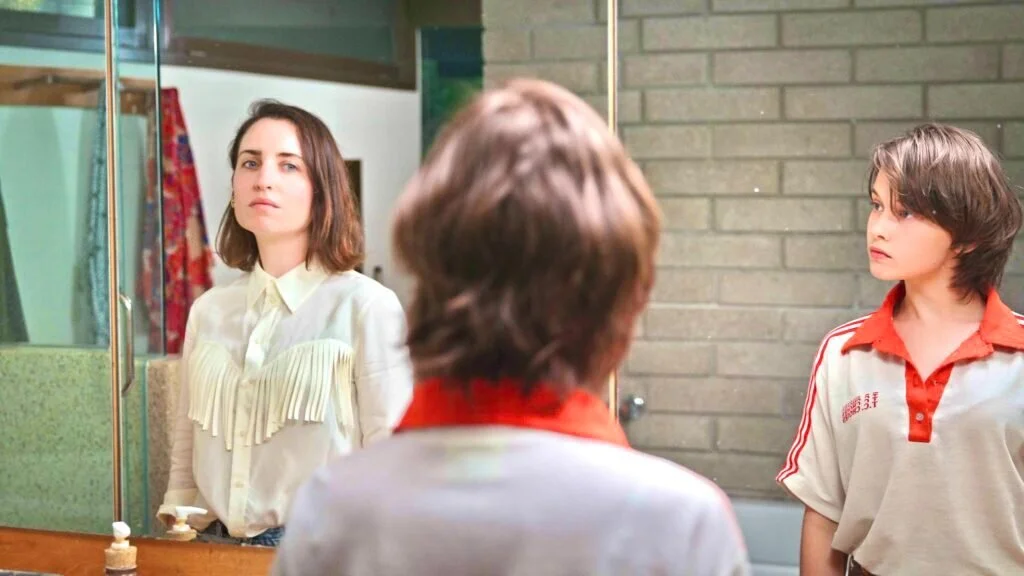Sundance 2021: The World to Come
At one point in Mona Fastvold's adaption of the 2017 short story from Jim Shepard The World to Come, lead character Abigail (Katherine Waterston) writes, "With little pride, and less hope, we begin the new year." It is a line emblematic of the wintry conditions and skeletal trees that lock these characters into their remote homestead cabins. They are isolated from civilization by what seems like impossible tracts of rocky and blisteringly cold terrain and when the flickering, gold candles of their lamps lick their faces in wavy streaks, the crackling grain of the 16mm filmstock seems a vision of their nerves fighting valiantly against frostbite. This is the story of two women, Abigail and Tallie (Vanessa Kirby), who live with two separate men Dyer (Casey Affleck, also co-producer) and Finney (Christopher Abbott), respectively. It follows the perspective of Abigail - a woman grappling with the grief of the loss of her firstborn to illness - who seeks comfort in her newest neighbor, Tallie.
As the landscape traps its fallen bed of leaves with hard layers of ice, Tallie comes to visit more and more often. She comes bearing gifts that seem an excuse to shed her boots and spend the long hours of the day in Abigail's company. And, bit by bit, their feelings for one another unfurl. Abigail is not remote from her husband, but their loss has driven a wedge between them. She rebukes his attempts to start anew. Tallie's husband, on the other hand, is controlling. He struggles with inadequacy and loneliness and takes it out on Tallie, driving her away and into the arms of Abigail. All the while, nature threatens to strangle what fragile union these two women forge, blocking their paths to one another with oceans of snow and setting nearby cabins alight.
The film is made and works so well because of its sublime performances. Waterston and Kirby are wonderful together with natural chemistry that ebbs and flows everytime they are given the chance to share each other's company. And, though their situation is fraught with danger, Fastvold and writer Ron Hansen are keen to give them the space and time to live in the safe havens they carve out at pivotal points in the story. These moments are breaths of fresh air as the two women loll about in autumnal forests or sit beside a crackling fire, enjoying one another's company before, ever so slowly, beginning to indulge in their unvoiced desires. Waterston's narration is a persistent voice throughout the film, as Abigail pours her heart out into her journal. And it provides a wonderful anchoring point for the narrative.
At the same time, what Waterston and Kirby are able to accomplish with a glance or a subtle flash of a smile renders the, admittedly eloquently penned entries somewhat superfluous. And, though this style, undoubtedly, worked in prose, as a film, it often feels as though the filmmakers were so enamored with the words on the page that they were unwilling to trust that they could divorce themselves from simple language and lean into what works so stupendously about the film: the images. This isn't to say that Hansen's adaptation of Shepard's words isn't stunningly beautiful, it often is. But, I found myself wishing, at moments, that I could just watch these characters interact, instead of listening to them recounting the episodes in memory, because they so compellingly and beautifully craft a believable romance.
Visually, the film is a gorgeous view of frontier America, with rugged landscapes of grey rock and orange leaves, of blindingly white snow and mossy green landscapes. It loses its luster somewhat, at night, when the images are saturated in charcoal-black shadow, which crushes detail in the backgrounds. This too serves a purpose: to focus in on the characters' faces and strip away all the visual chaff. But, for a film so remarkably naturalistic in its imagery elsewhere, the choice seems an odd one and one which feels contrary to the visual style that Fastvold has so meticulously crafted in all the other scenes awash in daylight. And, given how much the actors rely on non-verbal storytelling - a shift in posture, a force of habit, a fidgety movement - the choice seems doubly peculiar.
Still, this is an excellent film that, just by its performances, is worth a watch. It is a beautifully restrained story of love that still finds space to give its characters the safety and room to play. Some of its paces may be familiar and some of its lighting choices may befuddle, but this is a gorgeous romance and one of the best of the 2021 Sundance Film Festival.










